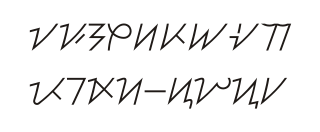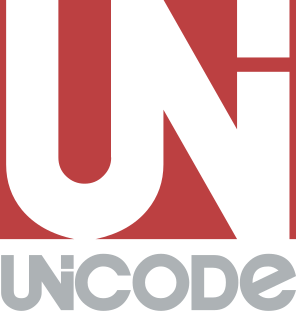
An abugida, or alphasyllabary, is a segmental writing system in which consonant–vowel sequences are written as a unit: each unit is based on a consonant letter, and vowel notation is secondary. This contrasts with a full alphabet, in which vowels have status equal to consonants, and with an abjad, in which vowel marking is absent, partial, or optional. The terms also contrast them with a syllabary, in which the symbols cannot be split into separate consonants and vowels. Abugidas include the extensive Brahmic family of scripts of South and Southeast Asia, Semitic Ethiopic scripts, and Canadian Aboriginal syllabics.
The Brahmic scripts are a family of abugida or alphasyllabary writing systems. They are used throughout the Indian subcontinent, Southeast Asia and parts of East Asia, including Japan in the form of Siddhaṃ. They are descended from the Brahmi script of ancient India, and are used by languages of several language families: Indo-European, Dravidian, Tibeto-Burman, Mongolic, Austroasiatic, Austronesian, and Tai. They were also the source of the dictionary order of Japanese kana.
The Burmese alphabet is an abugida used for writing Burmese. It is ultimately a Brahmic script adapted from either the Kadamba or Pallava alphabet of South India, and more immediately an adaptation of Old Mon or Pyu script. The Burmese alphabet is also used for the liturgical languages of Pali and Sanskrit.

The Soyombo script is an abugida developed by the monk and scholar Zanabazar in 1686 to write Mongolian. It can also be used to write Tibetan and Sanskrit.
The Balinese script, natively known as Aksara Bali and Hanacaraka, is an alphabet used in the island of Bali, Indonesia, commonly for writing the Austronesian Balinese language, Old Javanese, and the liturgical language Sanskrit. With some modifications, the script is also used to write the Sasak language, used in the neighboring island of Lombok. The script is a descendant of the Brahmi script, and so has many similarities with the modern scripts of South and Southeast Asia. The Balinese script, along with the Javanese script, is considered the most elaborate and ornate among Brahmic scripts of Southeast Asia.
The Batak script, natively known as surat Batak, surat na sampulu sia, or si-sia-sia, is a writing system used to write the Austronesian Batak languages spoken by several million people on the Indonesian island of Sumatra. The script may be derived from the Kawi and Pallava script, ultimately derived from the Brahmi script of India, or from the hypothetical Proto-Sumatran script influenced by Pallava.
Makassarese is a language of the Makassarese people, spoken in South Sulawesi province of Indonesia. It is a member of the South Sulawesi group of the Austronesian language family, and thus closely related to, among others, Buginese.

The Tamil script is an abugida script that is used by Tamils and Tamil speakers in India, Sri Lanka, Malaysia, Singapore, Indonesia, and elsewhere to write the Tamil language, as well as to write the liturgical language Sanskrit, using consonants and diacritics not represented in the Tamil alphabet. Certain minority languages such as Saurashtra, Badaga, Irula, and Paniya are also written in the Tamil script.

The Khmer script is an abugida (alphasyllabary) script used to write the Khmer language. It is also used to write Pali in the Buddhist liturgy of Cambodia and Thailand.
Telugu script, an abugida from the Brahmic family of scripts, is used to write the Telugu language, a Dravidian language spoken in the South Indian states of Andhra Pradesh and Telangana as well as several other neighbouring states. The Telugu script is also widely used for writing Sanskrit texts and to some extent the Gondi language. It gained prominence during the Eastern Chalukyas also known as Vengi Chalukya era. It shares extensive similarities with the Kannada script, as it has evolved from Kadamba and Bhattiprolu scripts of the Brahmi family. Both Adikavi Pampa of Kannada and Adikavi Nannayya of Telugu hail from families native to the Vengi region.

The Odia script, also known as the Oriya script) is a Brahmic script used to write the Odia language.

Tagbanwa, also known as Apurahuano, is one of the suyat writing systems of the Philippines used by the Tagbanwa people as their ethnic writing system and script.
The Limbu script is used to write the Limbu language. It is a Brahmic type abugida.

The Tai Le script, or Dehong Dai script, is a script used to write the Tai Nüa language of south-central Yunnan, China. It is written in horizontal lines from left to right, with spaces only between clauses and sentences.
New Tai Lue script, also known as Xishuangbanna Dai and Simplified Tai Lue, is an alphabet used to write the Tai Lü language. Developed in China in the 1950s, New Tai Lue is based on the traditional Tai Tham alphabet developed c. 1200. The government of China promoted the alphabet for use as a replacement for the older script; teaching the script was not mandatory, however, and as a result many are illiterate in New Tai Lue. In addition, communities in Burma, Laos, Thailand and Vietnam still use the Tai Tham alphabet.

The classical or traditional Mongolian script, also known as Hudum Mongol bichig, was the first writing system created specifically for the Mongolian language, and was the most successful until the introduction of Cyrillic in 1946. Derived from the Old Uyghur alphabet, Mongolian is a true alphabet, with separate letters for consonants and vowels. The Mongolian script has been adapted to write languages such as Oirat and Manchu. Alphabets based on this classical vertical script are used in Inner Mongolia and other parts of China to this day to write Mongolian, Xibe and experimentally, Evenki.

The Bamum scripts are an evolutionary series of six scripts created for the Bamum language by King Njoya of Cameroon at the turn of the 19th century. They are notable for evolving from a pictographic system to a partially alphabetic syllabic script in the space of 14 years, from 1896 to 1910. Bamum type was cast in 1918, but the script fell into disuse around 1931. A project began around 2007 to revive the Bamum script.

Hanunuo, also rendered Hanunó'o, is one of the indigenous suyat scripts of the Philippines and is used by the Mangyan peoples of southern Mindoro to write the Hanunó'o language.

Kulitan is one of the various indigenous suyat writing systems in the Philippines. It was used for writing Kapampangan, a language mainly spoken in Central Luzon, until it was succeeded by the usage of the Latin alphabet imposed by Spanish colonialists.
















